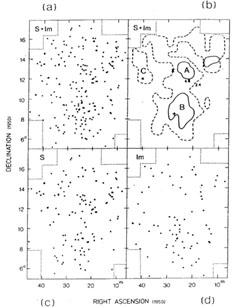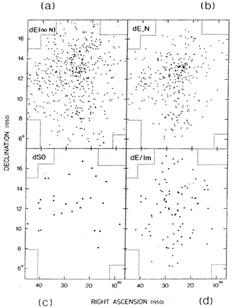


Speculation exists that galaxies can change their Hubble types in the harsh environment of clusters. The most persistent of such notions is that S0's are stripped spirals. However, the variation of surface brightness along the Hubble sequence belie all simple stripping arguments; S0 galaxies have as high a mean SB as do the brightest E galaxies, and this level of surface brightness is much higher than any present-day spiral disk, showing clearly that S0's are generic to the Hubble sequence, not formed either by mergers or by the stripping of later type spirals (Sandage 1983).
However, various types of data do suggest that some types of dwarf galaxies may have been transformed from other types. Clear evidence is the following:
(1) No Im dwarfs exist within 2° (radius) of M87, near the center of the dE swarm that defines the center of Virgo subcluster A. Figure 15 shows the hole in the Im distribution (panel d). The Virgo cluster environment is harshest in this region because of the strong X - ray flux from M87. The absence of the fragile Im types in this region suggests sweeping.

|
Figure 15. Distribution of late type Virgo cluster members over the face of the cluster. Panel (d) shows the hole in the Im distribution in the region near M87. Contrast the distributions here with those of the early type dE dwarfs in Figure 16. Diagram is from Figure 10 of BTS 87. |
(2) Im dwarfs also avoid the center of the Fornax cluster. Ferguson's morphological maps show that the region near NGC 1399 is devoid of Im and late type spirals over an area of 2° in diameter. As in Virgo, this region has the highest concentration of dE types which themselves define the center of the Fornax cluster. NGC 1399 is an X-ray source.
The statistical significance of the holes in the Im distribution in both Virgo and Fornax is questioned by Ferguson, but there can be no doubt that the ratio of dE to Im types in each cluster is a strong function of position. The ratio peaks at each cluster's center. The variation of this ratio with position is striking and beyond doubt. It can be seen by comparing Figures 15a, c, and d with Figure 16a and b, taken from Figures 9 and 10 of BTS 87.
(3) Figures 16a and b show the significant difference in the distribution of Virgo cluster dE galaxies depending whether they have nuclei (dE,N type) or not. Based on these data BTS 87 concluded that "non-nucleated dwarfs are more dispersed than nucleated ones."

|
Figure 16. Distribution of dE types (with and without bright unresolved nuclei) in Virgo. Contrast with Figure 15 for the late type dwarfs and note the difference in the concentrations toward the center of cluster A of dE,N and dE (no N) in panels (a) and (b). Diagram is from Figure 9 of BTS 87. |
The same effect has been found in Fornax. By fitting density profiles to the projected number distributions in Virgo and in Fornax we could show (Ferguson and Sandage 1989, hereafter FS 89) that the bright dE,N galaxies have an exponential scale length in their distribution like that of E, S0 giants and faint dE's. In contrast, the bright dE's with no nuclei have the same distribution as the spirals and the Im types. The result is definite in both clusters, suggesting that the subset of bright dE (no N) dwarfs has had a different formation history than the dE,N dwarfs with nuclei and that they may therefore be related to Im's.
However, belying this it has been clear for some time that present day dE (no N) galaxies cannot simply be stripped Im's because the SBs of the dE's are higher than would be the end product of such a stripping of present day Im types (Hunter and Gallagher 1985, Binggeli 1986, Bothun et al. 1986). Because of this strong counter argument no definite conclusion is possible at the moment.
(4) The two most potent arguments that dE's are not stripped Im's (Sandage, Binggeli, and Tammann 1985) were always: (a) Im's do not have sharp nuclei like the very bright (reaching as bright as absolute magnitude MB = -13) unresolved nuclei of dE,N's, and (b) the flattening distribution of dE's as a whole is different from Im's. But with the distinction now made between dE's and dE,N's in point (3) above, these arguments have lost their strength. FS 89 show that the flattening distribution differs between dE and dE,N, and that the bright dE (no N) have the same flattening distribution as the Im's! It would seem that an obvious evolutionary conclusion concerning stripping might follow from these data.
A summary of environmental processes in clusters is given by Gallagher and Hunter (1989) where various transformation possibilities are discussed.